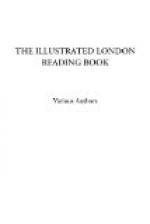[Illustration]
“As I and my people,” writes Macomo, “have been driven back over the Chunice, without being informed why, I should be glad to know from the Government what evil we have done. I was only told that we must retire over the Chunice, but for what reason I was not informed. It was agreed that I and my people should live west of the Chunice, as well as east of it. When shall I and my people be able to get rest?”
* * * * *
RAILWAY TUNNELS.
[Illustration: Letter O.]
Of the difficulties which occasionally baffle the man of science, in his endeavours to contend with the hidden secrets of the crust of the earth which we inhabit, the Kilsby Tunnel of the London and North-western Railway presents a striking example. The proposed tunnel was to be driven about 160 feet below the surface. It was to be, as indeed it is, 2399 yards in length, with two shafts of the extraordinary size of sixty feet in diameter, not only to give air and ventilation, but to admit light enough to enable the engine-driver, in passing through it with a train, to see the rails from end to end. In order correctly to ascertain, and honestly to make known to the contractors the nature of the ground through which this great work was to pass, the engineer-in-chief sank the usual number of what are called “trial shafts;” and, from the result, the usual advertisements for tenders were issued, and the shafts, &c. having been minutely examined by the competing contractors, the work was let to one of them for the sum of L99,000. In order to drive the tunnel, it was deemed necessary to construct eighteen working shafts, by which, like the heavings of a mole, the contents of the subterranean gallery were to be brought to the surface. This interesting work was in busy progress, when, all of a sudden, it was ascertained, that, at about 200 yards from the south end of the tunnel, there existed, overlaid by a bed of clay, forty feet thick, a hidden quicksand, which extended 400 yards into the proposed tunnel, and which the trial shafts on each side of it had almost miraculously just passed without touching. Overwhelmed at the discovery, the contractor instantly took to his bed; and though he was justly relieved by the company from his engagement, the reprieve came too late, for he actually died.
The general opinion of the several eminent engineers who were consulted was against proceeding; but Mr. R. Stephenson offered to undertake the responsibility of the work. His first operation was to lower the water with which he had to contend, and it was soon ascertained that the quicksand in question covered several square miles. The tunnel, thirty feet high by thirty feet broad, was formed of bricks, laid in cement, and the bricklayers were progressing in lengths averaging twelve feet, when those who were nearest the quicksand, on driving into the roof, were




